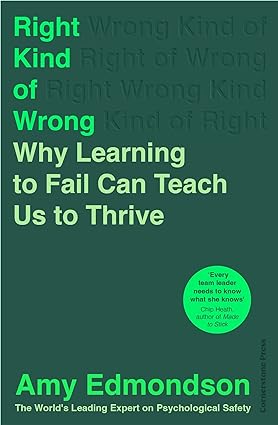
HomeRight kind of wrong By Amy EdmondsonBook SummaryRight kind of wrong By Amy Edmondson
Right kind of wrong By Amy Edmondson
April 19, 2024
Right kind of wrong By Amy Edmondson

- Binod Shankar
- Book Summary
My Top 40 takeways:
- The book categorizes failures into three types:
- Basic Failure: you were supposed to take a left but you took right. Can be avoided by using checklist.
- Complex failures: you were supposed to take left but you can’t because of an accident. These failures are caused due to complicated interdependency in the system. It can be avoided/mitigated by smarter system design.
- Intelligent failure: you don’t know of you have to take left or right. You chose one and learn from the mistake. These failures happen in unknown territories and are rich source of information.
- There are three categories of contexts in which failure can occur:
- Consistent– There is well developed knowledge about how to achieve the desired results. Think recipe.
- Novel– Creating something new. There is no roadmap or recipe that reliably leads to results. Think exploration.
- Variable– Discontinuities where existing knowledge appears consistent or inside a skill set but for which the conditions have changed to make the existing knowledge insufficient. Think COVID-19.
- Failing well is hard because of our aversion to failure, our confusion about what type of failure we’re experiencing, and fear of social stigma and excessive consequences.
- While aversion is natural, there are ways to minimize it through reframing failure as opportunities for learning. Confusion is addressed with clarity around the types of contexts and the type of failures. Fear often looms largest of all – but it, too, can be addressed. Not just by using the techniques to shape the amount of risk taken but by better understanding fear.
- When we do not admit mistakes or do not point out mistakes, we allow them to turn into larger ones. Also, we do not get the help we need.
- When someone, who works for Toyota, spots a problem, she or he pulls a cord above her or his workstation to prevent the problem from compounding. The cord conveys the message “We want to hear from you.”
- People like others more, not less, when they disclose vulnerabilities. This is partly because we respect their courage.
- One of the most important strategies for avoiding complex failures is emphasizing a preference for speaking up openly and quickly. In other words, making it psychologically safe to be honest about a small thing before it snowballs into a larger failure.
- The most effective hospital teams can report errors without fear of being blamed. Also in aviation, anyone can report an error without the name of the person who made the error. Regulations guarantee that information is confidential, voluntary and non-punitive. Blameless reporting is part of a coordinated learning system.
- People make mistakes because of inattention. Example: Forgetting to charge the smartphone. Fatigue plays a role in slips due to inattention. A third of adult Americans do not get enough sleep.
- People make mistakes when making wrong assumptions. Example: We have always used fossil fuels. So, the evidence of negative effects on the environment must be false or exaggerated.
- People make mistakes because of overconfidence. Not thinking about the implications of a decision is a common underlying cause. Example: Not consulting weather reports when doing something outside.
- People make mistakes because of neglect. Example: A damaged floor caused by leak from a sink, which persisted too long.
- Elite failure practitioners test things. They want to understand the world and do that by interacting with it.
- When you are working on a task where the purpose is learning, then avoid focusing on execution and feeling that you are supposed to know the answers to everything. Instead, experiment and learn.
- People, who are higher up in the hierarchy, are more likely to blame factors other than themselves compared to those with less power.
- Some people are more resilient than others. Why? 1. They are less prone to perfectionism, less likely to hold themselves to unrealistic standards. 2. Resilient people make more positive attributions about events than those who become anxious or depressed. Their way of explaining failure to themselves is more balanced and realistic rather than exaggerated and colored by shame.
- An intelligent failure has 4 attributes: 1. It takes place in new territory. 2. It is pursuing a meaningful opportunity to advance toward a desired goal. 3. It is informed by available knowledge. 4. It is as small as it can be to still provide valuable insights.
- Requiring managers to rank employees from best to worst is a cooperation killer.
- Most accidents result from a series of small process failures lining up than from one person’s error. Error exposes truth.
- My goal is to make basic failures fewer and further between. It’s the opposite of intelligent failures which I believe we should strive to increase.
- The failure craze- the “fail fast, fail often” culture that wants us to embrace failure indiscriminately- takes inspiration from the intelligent failures inherent to innovation but risks glossing over the vast and varied failure landscape which also includes basic and complex failure.
- Unlike intelligent failures, which takes place in new territory, complex failures occur in settings where you can find plenty of prior knowledge. Most of the accidents, tragedies and disasters that appear in the daily news are complex failures in reasonably familiar settings. Complex failures sometimes unfold over decades.
- Goleman wrote about mechanisms at 3 levels- cognition, group dynamics and institutional systems- that reinforce one another and blind us to unwelcome truths.
- Confirmation biases are fueled by our natural motivation to maintain self-esteem. Those who score high in Narcissism experience greater confirmation bias. Narcissism levels have been rising for decades.
- The Amygdala operates according to a “better safe than sorry” logic. From a survival perspective, an organism is better off reacting to a false positive than failing to react to a false negative. But today that same fear module makes us unwilling to take career and life enhancing personal risks that no longer threaten survival.
- People learn less from being given information about what they get wrong than about what they get right. Success feedback is more effective than failure feedback./li>
- The common response to failure is to stop paying attention rather than to learn anything valuable because failure is ego threatening. But it seems we are pretty good at learning from other people’s failures. In real life however we often don’t hear about them.
- You have probably experienced near misses in your life. Framing matters. If you have framed the close call as a success you are more likely to tell family or colleagues about it, making all of you more able to learn from it.
- Shame is a belief that “I am bad”. Guilt in contrast is a realization that “what I did is bad’. Its thus better to feel guilty than ashamed. Shame is highly correlated with addiction, depression, violence, aggression, bullying, suicide, eating disorders… while guilt is inversely correlated with those things”
- A learning frame is not only healthier, its also more rational than a performance frame. Its more in tune with the uncertainty & constant challenges found in any life or job.
- When you are working on a task where the purpose is learning, then avoid focusing on execution and feeling that you are supposed to know the answers to everything. Instead, experiment and learn.
- Too many failures in life happen (and they are more emotionally painful than they need to be) because we don’t pay attention to context- is it learning or execution?
- Have fun experimenting when the stakes are low.
- Getting into the habit of recoding the risk level in many of our activities, along with the stakes, is a vital, life enhancing capability. By cultivating this habit, we lighten the emotional load. We have more than enough situations in life where vigilance is essential.
- Most people’s education hadn’t prepared them to see systems. Ever increasing specialization threatens our ability to appreciate how systems work.
- System awareness also helps you feel less bad about some of the things that go wrong in your work or personal life. You start to see that you are not wholly responsible for most of the failures that occur.
- We tend to think of cause and effect as operating in one direction and in a time bounded, local manner: X causes Y. We miss noticing how an intended result (Y) becomes a cause of something else (Z).
- We observed that nurses confronted “process failure” often. Their responses fell into two categories. What we called “first order problem solving” was a work around to complete the task without addressing causes of the problem. Like all quick fixes, work arounds created an illusion of effectiveness. Many of the nurses described a “hero feeling” from using work arounds. But this hero feeling loosened their motivation to engage in second order problem solving. Worse, the effort and time nurses put into workarounds contributed to burnout.
- Hobbies present a great arena in which to practice failure. Hobbies are about fun and the stimulation of learning something new rather than about achievement or making a living- a low stakes context.
- The quality of our apology matters. For an effective apology: clearly express remorse, accept responsibility and offer to make amends or changes. In formulating an apology, focus on your impact not on your intention.



